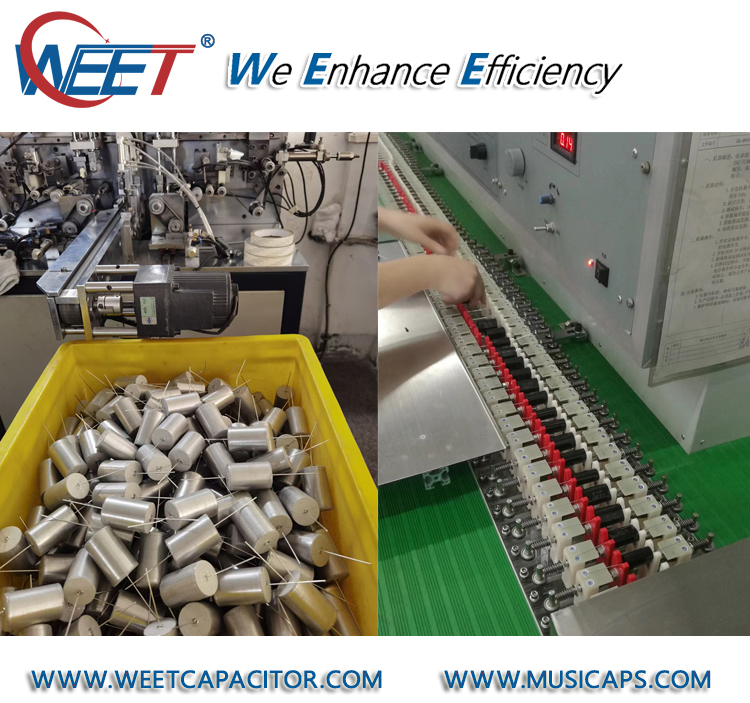WEE Technology Company Limited - WEE are Capacitors Specialist
WME 250V Precision Metallized Polypropylene Film Capacitors MKP Axial, OD*L:+/-1mm
Met Polypropylene Film Cap 20uF ±5% 250V OD*L:31*45mm Axial RoHS
Met Polypropylene Film Cap 25uF ±5% 250V OD*L:35*45.5mm Axial RoHS
Met Polypropylene Film Cap 40uF ±5% 250V OD*L:38.5*55.5mm Axial RoHS
Met Polypropylene Film Cap 50uF ±5% 250V OD*L:42*60mm Axial RoHS
Met Polypropylene Film Cap 70uF ±5% 250V OD*L:39.5*55mm Axial RoHS
Met Polypropylene Film Cap 120uF ±5% 250V OD*L:46.5*65mm Axial RoHS
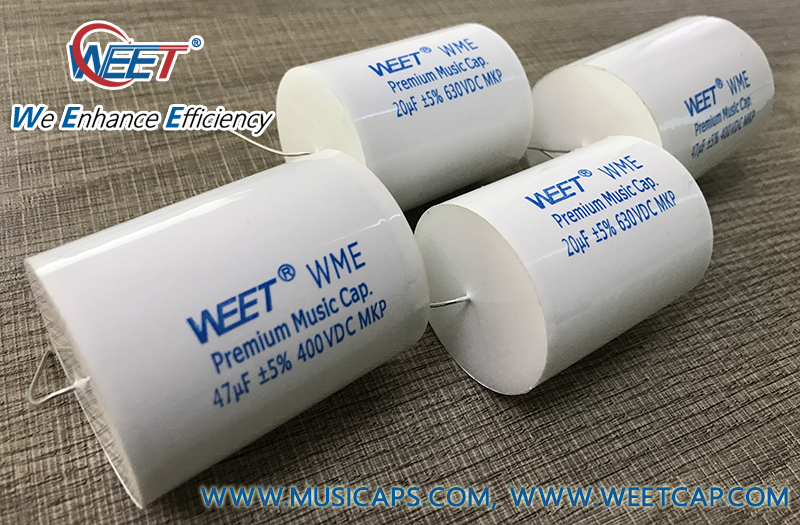
WEE Technology Company Limited - WEE are Capacitors Specialist
Firstly, we would like to say great thanks to our kind customer Mr. Alex Tsoupikov, he found WEET on internet and ordered our highest level audio capacitors at once.
Now he came back to us with his testing findings, we think it is an interesting thing to share with you, if you are also looking for high end audio capacitors for your crossover or tweeter applications.
TESTING RESULT:
I will test your aluminum and copper capacitors for 100 hours and write my opinion . I liked both types of WEET capacitors, both aluminum foil WMH and copper foil WMW for their sound neutrality. Caps with aluminum foil WMH are an absolutely bargain! Copper foil capacitors WMW create music with a great sense of realism, with a good balance between transparency and timbre. Excellent ratio of sound performance to cost !
Undoubtedly ,these will find your rightful place along with Jupiter, which , however are much more expensive. WEET Capacitors, Highly recommended !
--- From Alex Tsoupikov, Italy
Please find detailed Testimonial by clicking below link:
WEE Technology Company Limited - WEE are Capacitors Specialist
In order to give the best support to our end customers, distributors and wholesalers, we are glad to announce that we accept custom for audio capacitors.
Please check all related audio capacitors in below link, we only make qualified music capacitors.
https://www.weetcap.com/Audio-Capacitors/
Best seller Film and Foil Capacitors with reasonable price and outstanding sounding performance.
View more about WEET fctory: https://www.weetcap.com/Company_Photos/
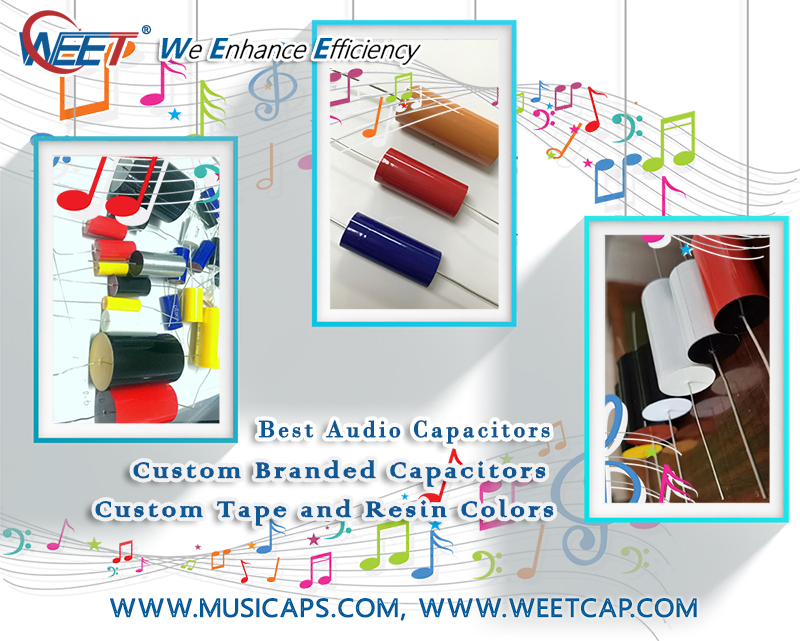
WEE Technology Company Limited - WEE are Capacitors Specialist
Dear Customer, may I have your attention please?
Our office is going to shut down on Sept 20th and Sept 21th for 2021 Mid Autumn Festival. Resume work on 22th Sept.
Please send us email as usual, we will reply on your email after our return.
Wish you and your family enjoy a happy Mid Autumn Festival.
Follow us on : http://www.youtube.com/c/WEETechnology
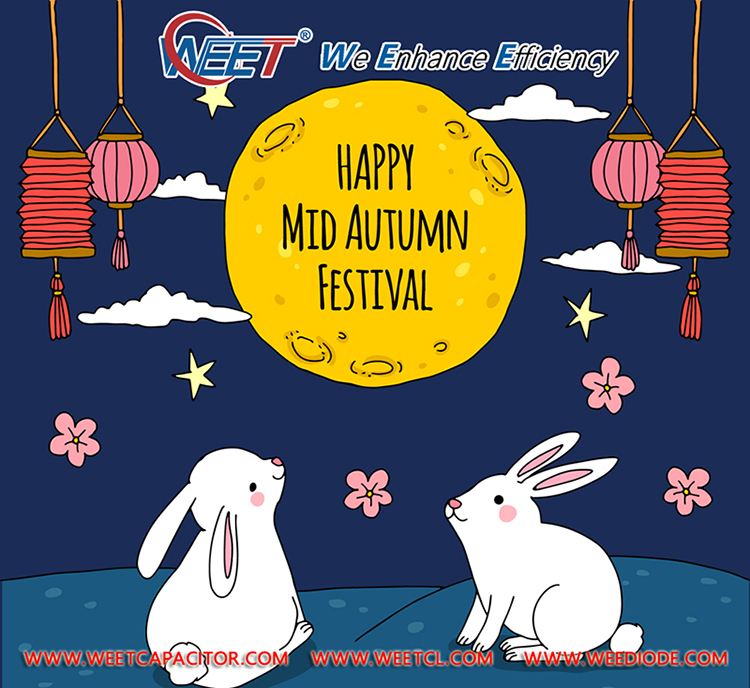
WEE Technology Company Limited - WEE are Capacitors Specialist
First of all, let us ask a question to all of the customers. Please refer to below two types of capacitors description and identity which one is Pure Copper Foil Audio Capacitors? And why?
1, Copper Foil MKP-T 2.2uF 100V OD*L 12.5*31mm, DF value 0.001
2, Copper Foil PPCT 2.2uF +/-5% 100V OD*L 23*64mm, DF value 0.0001
Well, WEET would like to answer it. No doubt, number 2 PPCT is the Pure Copper Foil Audio Capacitors. there are three reasons for it.
Firstly, PP refer to the original polypropylene insulation film, CT is the first letter of Chinese words “Chun Tong”, which means pure copper. Likewise, MKP is metallized polypropylene, T is the first letter of Chinese words “Tong”, which means copper. So MKP-T has no pure copper, but with plated copper material on the PP film surface, which is very thin and only one layer.
Secondly, as Pure Copper Foil PP Audio Capacitors have two layers, a layer of pure copper foil and a layer of PP film. So the size will be much bigger than copper plated foil MKP capacitors.
Regarding the sounding performance, Pure Copper Foil PP Audio Capacitors has much lower DF values. Lots of people want to try and hear how Pure Copper Foil PP Audio Capacitors sound, but due to high price tag, customers made hesitation.
However, price differences are used as a proxy for differences in quality. You deserve to hear the best sound of your speaker or audio application.
Know more about WEET WMW Pure Copper Foil PP Audio Capacitors winding method and stock list, please check below link, thank you.
WMW-100V | Pure Copper Foil and Film Polypropylene PP Capacitors Axial, D*L:+/-3mm |
0.22uF | WMW Copper Foil and Film PP 0.22uF 100V +/-3% 10x40 Axial RoHS |
0.33uF | WMW Copper Foil and Film PP 0.33uF 100V +/-3% 10x40 Axial RoHS |
0.47uF | WMW Copper Foil and Film PP 0.47uF 100V +/-3% 15x40 Axial RoHS |
0.68uF | WMW Copper Foil Film Met PP 0.68uF 100V +/-3% 16x40 Axial RoHS |
0.82uF | WMW Copper Foil and Film PP 0.82uF 100V +/-3% 18x40 Axial RoHS |
1uF | WMW Copper Foil and Film PP1.0uF 100V +/-3% 15x64 Axial RoHS |
1.5uF | WMW Copper Foil and Film PP 1.5uF 100V +/-3% 17x64 Axial RoHS |
2uF | WMW Copper Foil and Film PP 2.0uF 100V +/-3% 22x64 Axial RoHS |
2.2uF | WMW Copper Foil and Film PP 2.2uF 100V +/-3% 23x64 Axial RoHS |
3.3uF | WMW Copper Foil and Film PP 3.3uF 100V +/-3% 28x64 Axial RoHS |
WEET WMH Pure Copper Foil and Film Polypropylene PP Capacitors Winding:
Copper foil spliced to polypropylene insulation film. (a layer of pure Copper foil and a layer of PP film).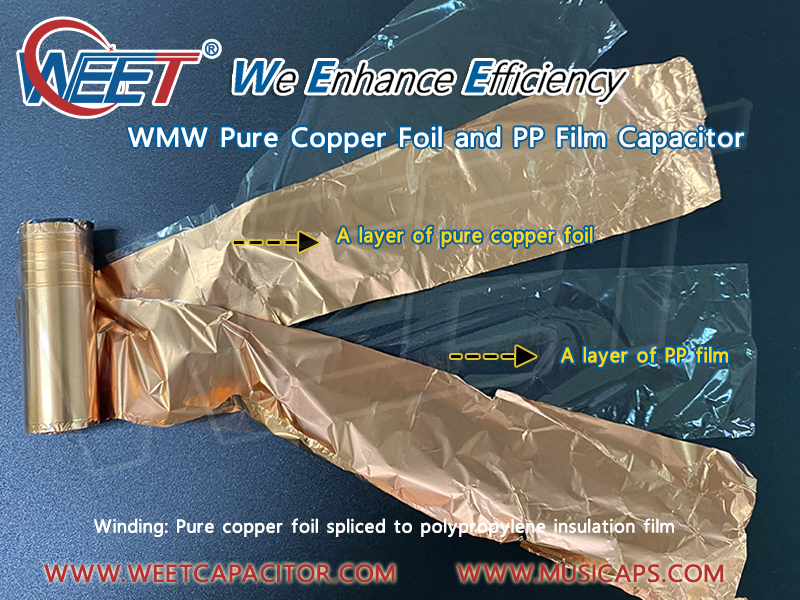
Other Factory Copper Plated Foil and MKP Film Audio Capacitors :
(Only one layer copper plated metallized polypropylene film )
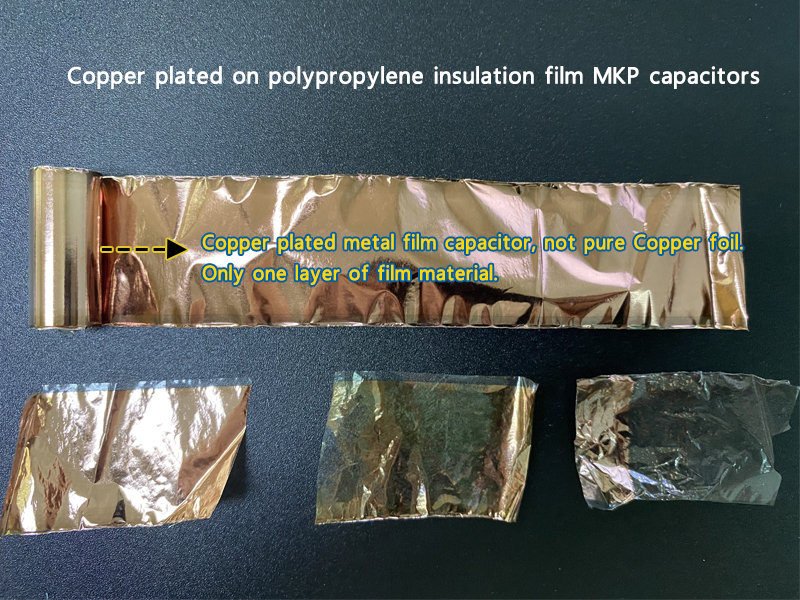
WEE Technology Company Limited - WEE are Capacitors Specialist
If you are very active in audio forums and related business filed, you must be quite familiar with “ Foil and Film” phrase. Maybe you will see lots of products names as Aluminum foil capacitor or Silver foil capacitor. Yes, that is true to some extents.
WEET engineers would like to tell you the advantages of Pure Aluminum Foil and Film Polypropylene PP Capacitors than Silver Plated Foil metallized polypropylene Audio Capacitors
The main Dielectric for both of the above two type capacitors are Polypropylene film, but Pure Aluminum Foil are winding by a layer of Pure Aluminum foil spliced to a layer of original polypropylene insulation film. There are two layers individually. So the size and weight for Pure Aluminum Foil are bigger and heavier than Silver Plated Foil Audio Capacitors
However, for Silver Plated Foil Audio Capacitors, there is only one layer winding on the core. Electroplating the metal composed of silver on the surface of the original PP film, which can also be called as metallized silver polypropylene film.
Regarding the sounding performance, pure foil PP capacitors has much lower DF (Dissipation factor) values than plated foil metallized polypropylene film capacitors.
Please check below datasheet of WEET WMH Pure Aluminum Foil and Film Polypropylene PP Capacitors and common items stock list.
https://weetcap.com/Audio-Capacitors/
WMH-100V | Pure Aluminum Foil and Film Polypropylene PP Capacitors Axial, D*L:+/-2mm |
1.0uF | WMH Aluminum Foil and Film PP 1.0uF 100V +/-3% 15x50 Axial RoHS |
1.5uF | WMH Aluminum Foil and Film PP 1.5uF 100V +/-3% 17x50 Axial RoHS |
1.8uF | WMH Aluminum Foil and Film PP 1.8uF 100V +/-3% 15x58 Axial RoHS |
2.0uF | WMH Aluminum Foil and Film PP 2.0uF 100V +/-3% 16x58 Axial RoHS |
2.2uF | WMH Aluminum Foil and Film PP 2.2uF 100V +/-3% 17x58 Axial RoHS |
2.7uF | WMH Aluminum Foil and Film PP 2.7uF 100V +/-3% 18x58 Axial RoHS |
3.0uF | WMH Aluminum Foil and Film PP 3.0uF 100V +/-3% 17x75 Axial RoHS |
3.3uF | WMH Aluminum Foil and Film PP 3.3uF 100V +/-3% 18x75 Axial RoHS |
3.9uF | WMH Aluminum Foil and Film PP 3.9uF 100V +/-3% 19x75 Axial RoHS |
4.0uF | WMH Aluminum Foil and Film PP 4.0uF 100V +/-3% 20x75 Axial RoHS |
4.7uF | WMH Aluminum Foil and Film PP 4.7uF 100V +/-3% 21x75 Axial RoHS |
5.0uF | WMH Aluminum Foil and Film PP 5.0uF 100V +/-3% 21x75 Axial RoHS |
5.6uF | WMH Aluminum Foil and Film PP 5.6uF 100V +/-3% 22x75 Axial RoHS |
6.0uF | WMH Aluminum Foil and Film PP 6.0uF 100V +/-3% 22x85 Axial RoHS |
6.8uF | WMH Aluminum Foil and Film PP 6.8uF 100V +/-3% 23x85 Axial RoHS |
7.0uF | WMH Aluminum Foil and Film PP 7.0uF 100V +/-3% 23.5x85 Axial RoHS |
8.0uF | WMH Aluminum Foil and Film PP 8.0uF 100V +/-3% 24x85 Axial RoHS |
8.2uF | WMH Aluminum Foil and Film PP 8.2uF 100V +/-3% 25x85 Axial RoHS |
9.0uF | WMH Aluminum Foil and Film PP 9.0uF 100V +/-3% 27x85 Axial RoHS |
10.0uF | WMH Aluminum Foil and Film PP 10.0uF 100V +/-3% 28x85 Axial RoHS |
WEET WMH Pure Aluminum Foil and Film Polypropylene PP Capacitors Winding:
Aluminum foil spliced to polypropylene insulation film. (a layer of pure Aluminum foil and a layer of PP film).
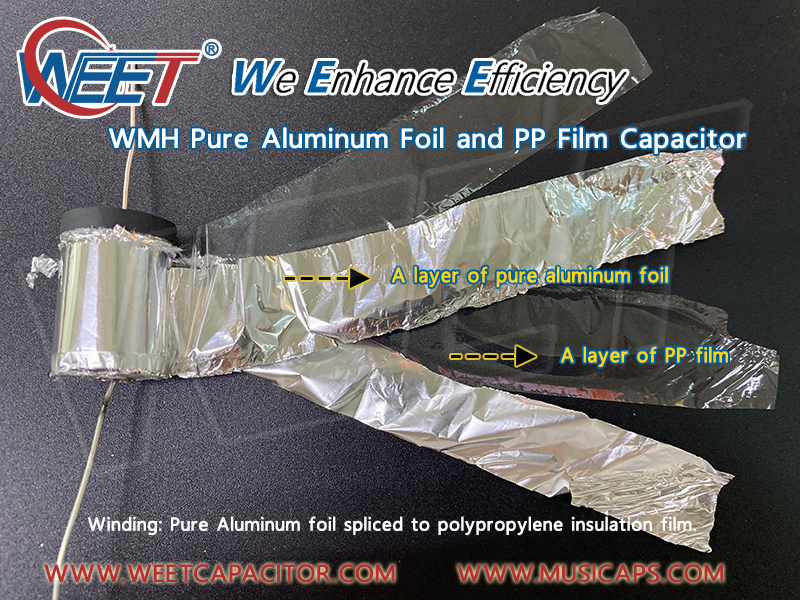
Other Factory Silver Plated Foil and MKP Film Audio Capacitors (Only one layer silver plated metallized polypropylene film )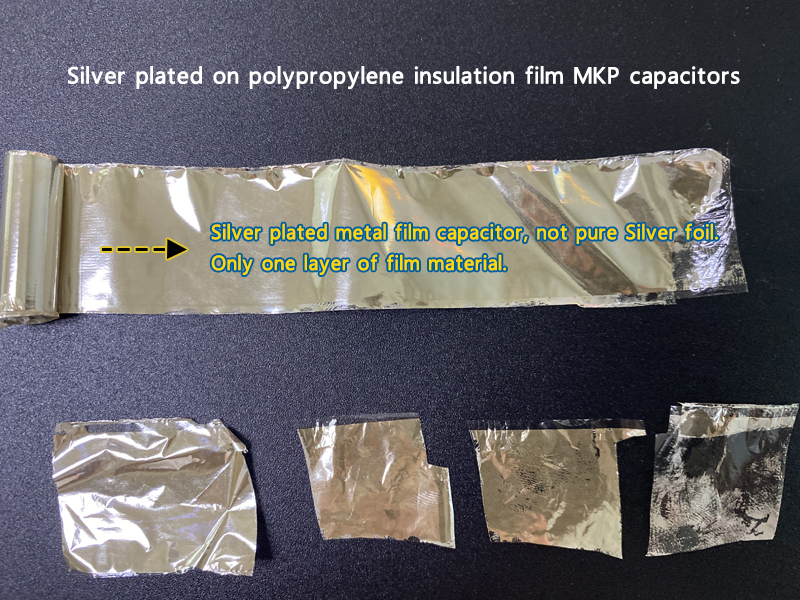
WEE Technology Company Limited - WEE are Capacitors Specialis
Here we would like to introduce the best welcoming audio capacitor WME series to all of the audiophilers.
Overview:
WEET WME MKP metallized polypropylene capacitors your standard choice for all of your loudspeaker projects! This high-quality Premium Audio film capacitor provide perfect sound quality.
Product Description:
WEET WME axial metallized polypropylene film capacitor is made of vacuum aluminum plated polypropylene film as the combination of dielectric and electrode. The electrode is led out by tinned copper wire and filled with 94V-0 epoxy resin. Capacitance range from 0.1uF~100uF, rated voltage is 400V.DC. Well, after plenty of burn-in time (that they need to open-up) they deliver a wide and open sound stage. Nice and neutral, WEET WME Premium sounds quite organized when compared with other standard MKP's in this price range. Like all basic MKP's they can get a bit muddled when complex programme material is fed to them but they do have a certain tidiness to them which makes them go further before that sets in. The WME Premium is reasonably well balanced and neutral and in a positive way nothing sticks out. This works especially well on recordings of jazz-trio's or other small ensembles making it easier to pick out the details. The Clarity Cap SA and ESA will give you more image depth and richer harmonic overtones and the Mundorf EVO Oil will give you sharper leading edges to notes but it must be stated that those capacitors are in a higher price bracket. It is just to give you an idea in what sound quality range we are looking at here.
Common and popular vales in WME series:
| WME-400V | WME Precision Metallized Polypropylene Film Capacitors MKP Axial, OD*L:+/-1mm |
| 1.0uF | WME Precision Met Polypropylene 1.0uF ±5% 400V OD*L:13.5*24mm Axial RoHS |
| 1.5uF | WME Precision Met Polypropylene 1.5uF ±5% 400V OD*L:13.5*30.5 Axial RoHS |
| 1.8uF | WME Precision Met Polypropylene 1.8uF ±5% 400V OD*L:15.5*30.5 Axial RoHS |
| 2.2uF | WME Precision Met Polypropylene 2.2uF ±5% 400V OD*L:16.5*30.5 Axial RoHS |
| 2.5uF | WME Precision Met Polypropylene 2.5uF ±5% 400V OD*L:17.5*30.5 Axial RoHS |
| 2.7uF | WME Precision Met Polypropylene 2.7uF ±5% 400V OD*L:18*30.5 Axial RoHS |
| 3.3uF | WME Precision Met Polypropylene 3.3uF ±5% 400V OD*L:19.5*30.5 Axial RoHS |
| 3.9uF | WME Precision Met Polypropylene 3.9uF ±5% 400V OD*L:21.5*30.5 Axial RoHS |
| 4.7uF | WME Precision Met Polypropylene 4.7uF ±5% 400V OD*L:18.5*45 Axial RoHS |
| 5.6uF | WME Precision Met Polypropylene 5.6uF ±5% 400V OD*L:20*45 Axial RoHS |
| 6.8uF | WME Precision Met Polypropylene 6.8uF ±5% 400V OD*L:22*45 Axial RoHS |
| 7.5uF | WME Precision Met Polypropylene 7.5uF ±5% 400V OD*L:23*45 Axial RoHS |
| 8.2uF | WME Precision Met Polypropylene 8.2uF ±5% 400V OD*L:24.5*45 Axial RoHS |
| 10uF | WME Precision Met Polypropylene 10uF ±5% 400V OD*L:27*45 Axial RoHS |
| 12uF | WME Precision Met Polypropylene 12uF ±5% 400V OD*L:29.5*45 Axial RoHS |
| 15uF | WME Precision Met Polypropylene 15uF ±5% 400V OD*L:32.5*45 Axial RoHS |
| 18uF | WME Precision Met Polypropylene 18uF ±5% 400V OD*L:32*55 Axial RoHS |
| 20uF | WME Precision Met Polypropylene 20uF ±5% 400V OD*L:33.5*55 Axial RoHS |
| 22uF | WME Precision Met Polypropylene 22uF ±5% 400V OD*L:35.5*55 Axial RoHS |
| 25uF | WME Precision Met Polypropylene 25uF ±5% 400V OD*L:37.5*55 Axial RoHS |
| 27uF | WME Precision Met Polypropylene 27uF ±5% 400V OD*L:39*55 Axial RoHS |
| 30uF | WME Precision Met Polypropylene 30uF ±5% 400V OD*L:41*55 Axial RoHS |
| 33uF | WME Precision Met Polypropylene 33uF ±5% 400V OD*L:43*55 Axial RoHS |
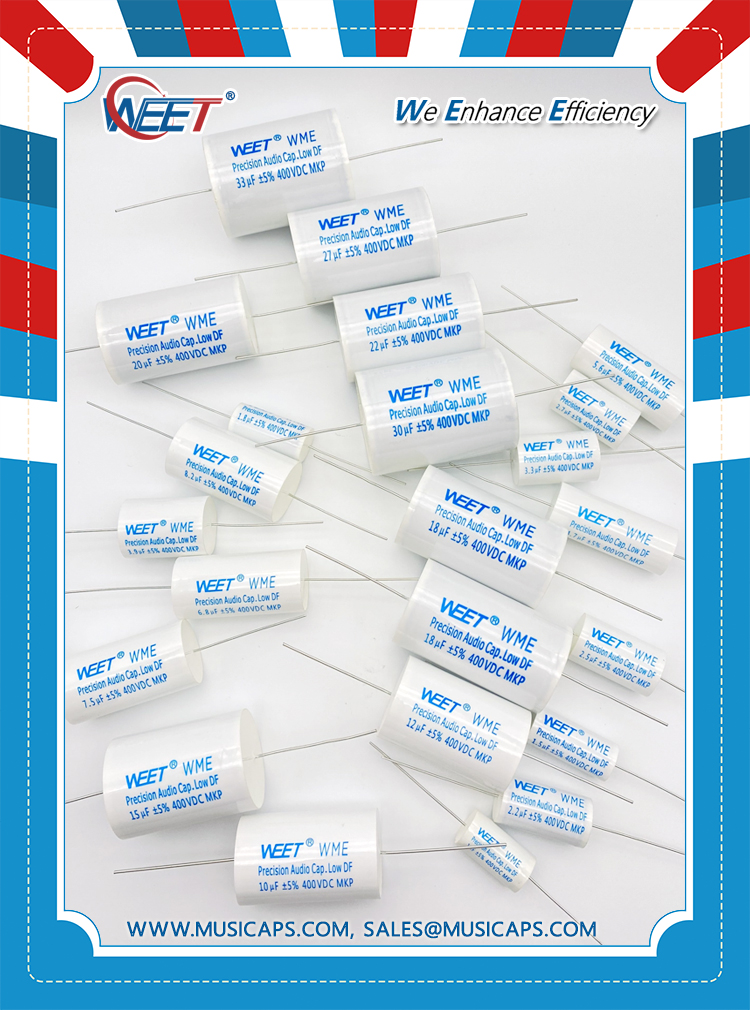
WEE Technology Company Limited - WEE are Capacitors Specialist
Do you know what the differences between WEET WME and WMF series are and what they are in common?
WME - Premium Music Film Capacitors:
WMF Precise Audio Film Capacitors:
Well, the size capacitance and voltage are the same for these two series.
WME is filled with white epoxy and white plastic sleeve with blue oil marking, WMF is filled with red epoxy and red plastic sleeve with black oil marking, the marking description is different too.
Most important difference is that MWF has lower DF than WME, even though WME already with low DF. For each item there is a specific DF value, please refer to our datasheet for details.
MKP Polypropylene CBB19 0.1uF ±5% 400V OD*L:6.5*18mm Axial RoHS
MKP Polypropylene CBB19 0.22uF ±5% 400V OD*L:8.5*18mm Axial RoHS
MKP Polypropylene CBB19 0.33uF ±5% 400V OD*L:10*18mm Axial RoHS
MKP Polypropylene CBB19 0.47uF ±5% 400V OD*L:9.5*24mm Axial RoHS
MKP Polypropylene CBB19 0.56uF ±5% 400V OD*L:10.5*24mm Axial RoHS
MKP Polypropylene CBB19 0.68uF ±5% 400V OD*L:11.5*24mm Axial RoHS
MKP Polypropylene CBB19 0.82uF ±5% 400V OD*L:12.5*24mm Axial RoHS
MKP Polypropylene CBB19 1.0uF ±5% 400V OD*L:13.5*24mm Axial RoHS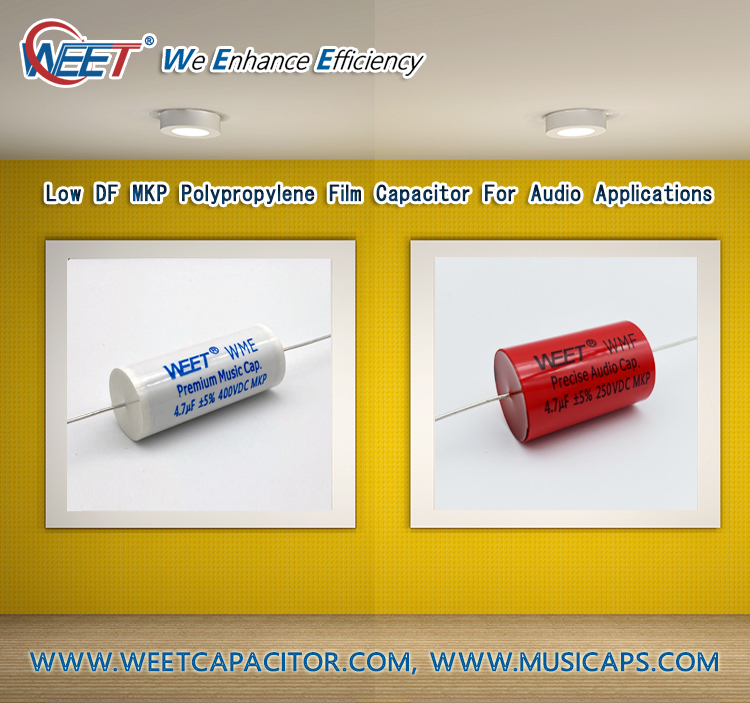
WEE Technology Company Limited - WEE are Capacitors Specialist
Firstly, we share some customer’s feedback about WEET WMW Pure Copper Foil Capacitor.
All in all, excellent product, well made and very happy thus far with the sound quality.The WEET Pure Copper Cap is very suitable for audio individual instruments. Very nice and coherent sounding with rich natural harmonics. The WEET Pure Copper Capacitor has a perfect balance between warmth and detail. The amount of detail and spatial information lets you hear the acoustics of the recording venue well.
You may be familiar with above testing review of Pure Copper Capacitor, which is true, because Audyn True Copper Caps are the same sound quality with WEET WMW Pure Copper Foil Capacitor. If you doubt about it, you should have a try and hear by yourself.
But considering of these European brands price, there is very small amount of customer who will be buyers. However, in the terms of price, WEET absolutely win. In order to compete with them and earn more market shares, WEET decided to do non-profit project for a period. From June to August, all the customers will enjoy 10% discount of the original price for WMW Pure Copper Foil Capacitor. First come, first served.
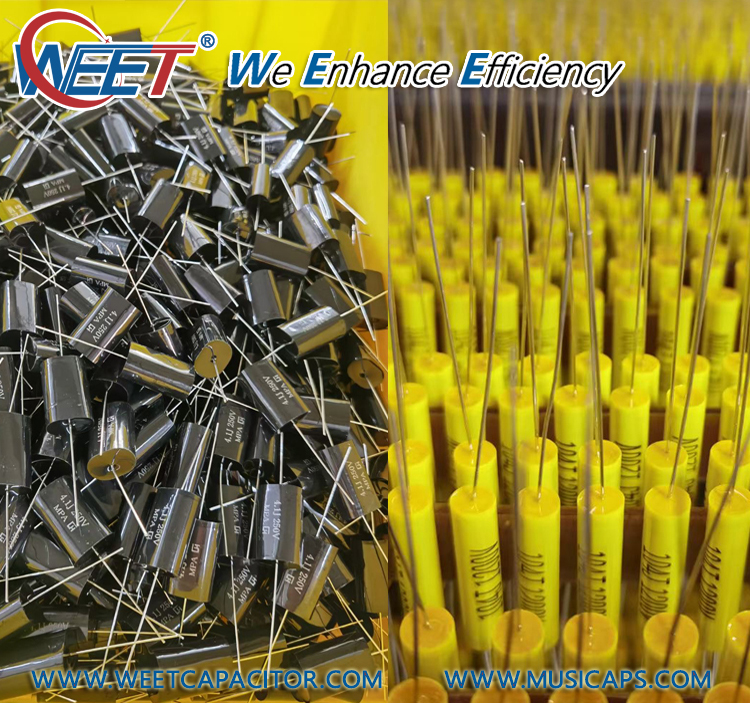
WEE Technology Company Limited - WEE are Capacitors Specialist
WEET is one of the oldest capacitors factory in China mainland and with a part of staffs in Taiwan development center, for pure aluminum foil capacitors, we manufactured the core part in our Taiwan office, and then assembly in Dongguan factory.
Now, we have introduced new machines for aluminum film and foil capacitors in our Dongguan factory and invited our chief engineer from Taiwan to our workshop to guide and train domestic operators. After nearly 6 months training and production line running, we are glad to share the news that we have successfully finished all the aluminum film and foil capacitor manufacturing process.
With this great achievement, we have saved a large amount of labor cost and transportation fee in Taiwan office, so it is a right now to lower down capacitors cost and provide more favorable price to our customers, please do not miss this opportunity. If you are in need of high end audio capacitors, contact with WEET as early as you can. We are ready to serve you at any time.
